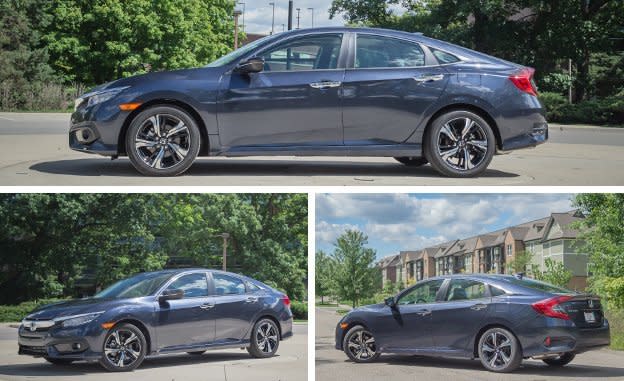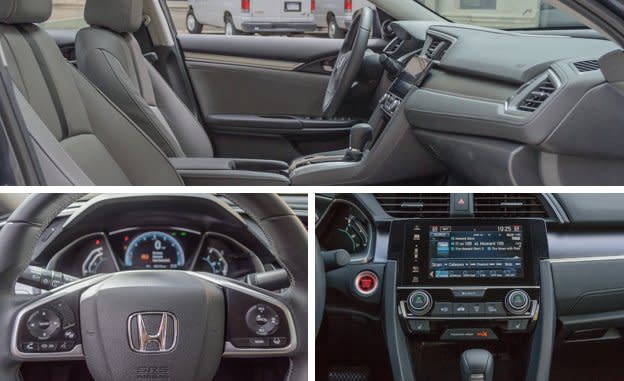2016 Honda Civic Sedan

It's hard to believe, but it has been nearly two decades since we last conducted a long-term test of a Honda Civic. A 1997 Civic HX coupe was the most recent example of Honda’s venerable compact to go through our 40,000-mile test regimen. Now, almost 19 years and four Civic generations later, we’re finally welcoming another one into the fold: a 2016 sedan in top-of-the-line Touring trim.
Why is this 10th-generation Civic important enough to warrant an extended closer look? First, because it’s a shot at redemption for Honda. The ninth-gen Civic drew critical ire, mostly for its plain styling and lack of driving verve. Early indications, including a strong second-place finish in a recent five-car comparison test, are promising. The new Civic certainly can’t be called plain, no matter the body style—the coupe, hatchback, and sedan versions all display curves and angles that are daring for a Civic. And the new Civic is a big deal for Honda in a broader sense, because this car’s platform was engineered right here in the U.S.A. by Honda’s Marysville, Ohio, team and will form the basis for all global versions of the Civic. It also will underpin the next Accord mid-size sedan and CR-V crossover.

Loaded to the Gills
To sample the full palette of what the new Civic has to offer, we opted for the sedan’s top Touring trim level. That means getting as standard the new 174-hp 1.5-liter turbocharged four-cylinder, the first forced-induction engine installed in a U.S. Honda product since the original 2007 Acura RDX. A continuously variable automatic is the only transmission choice for 2016 turbo Civics—yes, a six-speed manual is coming for certain boosted 2017 models, but we figure most stick-shift enthusiasts will wait for the upcoming Civic Si. Plus, Honda has had plenty of time to get CVTs right: even our ’97 Civic HX long-termer had one as a nod to its high-fuel-economy mission.
That’s about where the similarities between 1997 and 2016 end, technology-wise. Our Civic Touring is positively chock-full of the latest equipment, including a 7.0-inch central touchscreen with Apple CarPlay/Android Auto capability, dual-zone automatic climate control, push-button start, and a digital gauge cluster with customizable information displays. Honda’s full package of active-safety features is standard on the Touring, comprising adaptive cruise control, lane-keeping assist, forward-collision warning, the proprietary LaneWatch camera (which displays a view of the passenger-side blind spot on the main screen when the right turn signal is engaged), and a few other systems to help avoid accidents. Shelling out for the Touring model also affords a few features not available on any other Civic trim level, notably LED headlights, rain-sensing wipers, heated rear seats, a power passenger seat, a 450-watt premium audio system, and slightly thicker front and rear anti-roll bars.
All told, our Civic Touring’s $27,335 price might seem steep for a compact Honda. But we will say that our long-term BMW 740i, costing more than three times as much, at $96,095, is missing some of the Civic’s key features such as adaptive cruise, Apple CarPlay/Android Auto, and remote start.

So Far, So Good
After a month of road tripping and commuting, we find that comments in the Civic’s logbook are mostly positive. The powertrain has proved especially impressive, averaging a stellar 39 mpg—a figure made all the more remarkable when you consider our car clocked a zero-to-60-mph time of 6.9 seconds. The sharp steering and composed ride quality also are strong points. Several complaints have arisen concerning the central touchscreen, which is frustrating to use—as is its slider to adjust audio volume—along with the herky-jerky nature of the adaptive cruise control. The latter system’s bad behavior spurred some drivers into deactivating the adaptive function in favor of good old regular cruise—a handy feature not always included with these systems. It’s achieved by holding down the button that adjusts the following distance.
So, yes, maybe some of the Civic’s advanced tech features spur more frustration than actual advancement, but we’ll see how our opinions evolve as we live with the car. We’re also curious to find out how the Honda’s impressive fuel economy holds up as weather conditions change and the leadfoots around here get more time behind the wheel. But considering our initial impression of all-around goodness, at this point we’ll simply say that, after nearly 20 years, it’s nice to have a Honda Civic back in our long-term stable.
Months in Fleet: 1 month Current Mileage: 2380 miles
Average Fuel Economy: 39 mpg Fuel Tank Size: 12.4 gal Fuel Range: 480 miles
Service: $0 Normal Wear: $0 Repair: $0
Specifications >
VEHICLE TYPE: front-engine, front-wheel-drive, 5-passenger, 4-door sedan
PRICE AS TESTED: $27,335 (base price: $27,335)
ENGINE TYPE: turbocharged and intercooled DOHC 16-valve inline-4, aluminum block and head, direct fuel injection
Displacement: 91 cu in, 1496 cc
Power: 174 hp @ 6000 rpm
Torque: 162 lb-ft @ 1700 rpm
TRANSMISSION: continuously variable automatic
DIMENSIONS:
Wheelbase: 106.3 in
Length: 182.3 in
Width: 70.8 in Height: 55.7 in
Passenger volume: 95 cu ft
Cargo volume: 15 cu ft
Curb weight: 2920 lb
PERFORMANCE: NEW
Zero to 60 mph: 6.9 sec
Zero to 100 mph: 17.5 sec
Zero to 120 mph: 28.5 sec
Rolling start, 5–60 mph: 7.5 sec
Top gear, 30–50 mph: 4.0 sec
Top gear, 50–70 mph: 4.9 sec
Standing ¼-mile: 15.3 sec @ 94 mph
Top speed (governor limited): 126 mph
Braking, 70–0 mph: 179 ft
Roadholding, 300-ft-dia skidpad: 0.83 g
FUEL ECONOMY:
EPA city/highway driving: 31/42 mpg
C/D observed: 39 mpg
Unscheduled oil additions: 0 qt
WARRANTY:
3 years/36,000 miles bumper to bumper;
5 years/60,000 miles powertrain;
5 years/unlimited miles corrosion protection;
3 years/36,000 miles roadside assistance

 Yahoo Autos
Yahoo Autos 